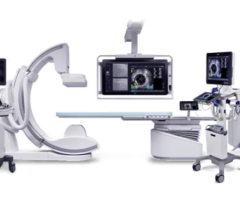
December 31, 2015 - The U.S. Food and Drug Administration (FDA) has cleared Biotronik's Astron Peripheral Self-Expanding Nitinol Stent System. The device is indicated for improving luminal diameter in patients with iliac atherosclerotic lesions in vessel reference diameters between 4.3 and 9.5 mm and lesion lengths up to 105 mm.
The Astron stent system is a self-expanding stent loaded on an over-the-wire delivery system. The stent is laser-cut from a nitinol tube. It carries four radiopaque extensions at each end and is completely coated with amorphous silicon carbide (a-SiC:H). The delivery system consists of two coaxially arranged elements: the inner shaft and the outer sheath. The inner shaft is made of a thermoplastic polymer. At the proximal end, it is covered with a stainless steel tube. The safety tab that covers the stainless steel tube prevents accidental stent release. The stainless steel tube incorporates a black release marker that indicates the completion of stent deployment and ends with a luer port at the proximal guide wire exit.
The central guide wire lumen within the inner shaft continues to the radiopaque tip. The stent is mounted between the inner shaft and the outer sheath proximal to the tip, between two radiopaque markers, which facilitate fluoroscopic visualization, and positioning of the delivery system towards and across the lesion. The outer sheath begins within the T-connector and extends towards the tip. It covers the stent and keeps it constrained within its distal end. A hydropholic coating is applied to the inside and outside of the entire outer sheath. The annular space between the inner shaft and the outer sheath can be flushed through the luer port at the T-connector. The guide wire lumen of the inner shaft is flushed through the luer port at the proximal guide wire exit. The guide wire lumen permits the use of 0.035” guide wires to facilitate advancement of the delivery system through the lesion to be treated. The stent system is shipped with an “Easy Release”-tube inserted over the proximal outer sheath. The “Easy Release” tube is intended to be inserted into the hemostatic valve of the introducer to reduce friction between the delivery system and the hemostatic valve during stent release. The stent system and the Easy Release tube are compatible with an appropriately sized introducer sheath according to the indications on the label. The stent is advanced to the intended implantation location by means of the over-the-wire delivery system and is deployed by pulling back the outer sheath at the T-Connector while immobilizing the inner shaft. The stent remains in the vessel as a permanent implant.
The Astron stent is available with fully expanded stent diameters of 7, 8, 9 and 10 mm and stent lengths of 30, 40, 60 and 80 mm.
Astron self-expanding nitinol stent systems have been market released outside the United States since October 2003. The FDA said the Astron stent system has not been subject to any Field Safety Corrective Action or recall since introduction.
For more information www.biotronik.com


 December 20, 2023
December 20, 2023 








